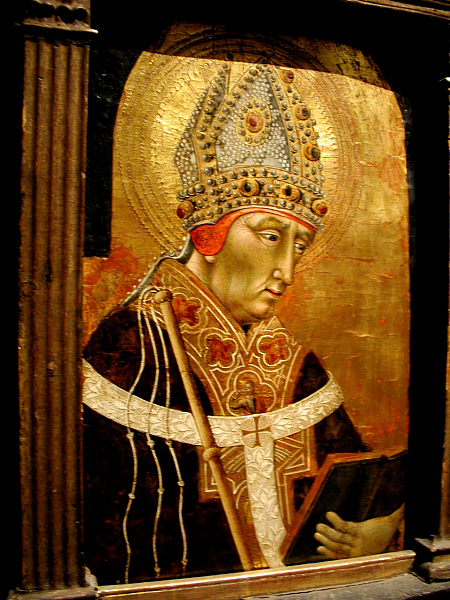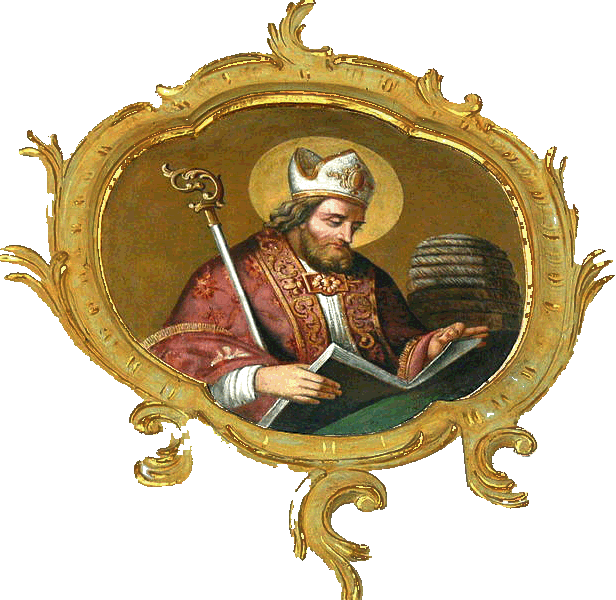In the art the emblem of St. Ambrose's assertiveness is often a riding whip (example).
In addition to this whip and his episcopal mitre and crozier, artists derived further attributes and subject matter from the Golden Legend. Some images use bees or a beehive as his attribute, as in the second picture at right. The Legend says a swarm of bees buzzed around his mouth when he was a child, leading his father to predict great things for him. Duchet-Suchaux (25) says some life-cycle paintings use a pointing boy to refer to the episode in the Legend when Ambrose was a governor and had to calm a near-riot between Arians and Catholics over who should be the next bishop of Milan. A boy pointed to him and called out that Ambrose should be chosen. The people agreed.
In another episode in the Legend, at the time of the death of St. Martin in Gaul, Ambrose in Milan had a vision in which he officiated at the saint's funeral rites (image).
Other attributes refer to his theological work: a book in his hand, an inspirational dove above him while he writes (example), or an ox to represent his commentary on the Gospel of Luke.
Finally, St. Ambrose figures in images of the life of St. Augustine, whom he baptized (example), and of SS. Gervasius and Protasius, whose cult he encouraged (example).
Prepared in 2014 by Richard Stracke, Emeritus Professor of English, Augusta University.
HOME PAGE

Giovanni di Paolo, St. Ambrose, 1465-70: Whip, book, mitre (See description page)

Fresco in an Austrian church: Beehive, mitre, crozier, book (See description page)
ATTRIBUTES
- Primary attribute: a flail with three cords
- Secondary attributes: beehive, dove
MORE IMAGES
- 12th century: A high relief set into the façade of the Basilica of St. Ambrose in Milan.
- 1390s: Among the saints on the left wing of Cenni di Francesco's Coronation of the Virgin altarpiece St. Ambrose holds up an open book.
- 1460-90: The Master of Liesborn's Saints Ambrose, Exuperius, and Jerome.
- Late 15th century: St. Ambrose is pictured with his flail in this painting of the Four Doctors of the Church.
- 16th century: Statue in the monastery in Sobrado, Spain.
- 1702: Statue in the monastery in St. Florian, Austria.
- Undated, possibly 19th century: Painting with a beehive for an attribute.
DATES
- Feast day: December 7
- Lived 339-397
BIOGRAPHY
- Golden Legend #57: html or pdf
- Letter 51: To Theodosius on the Thessalonian Massacre
- Augustine on the penitence of Theodosius: City of God, V, xxvi.
- Ambrose's vita in the Roman Breviary for December 7 — English translation: I, 629-30. Latin original: 778-79.
ALSO SEE
NOTES
1 Theodosius had ordered the massacre of the people of Thessalonica because they had rioted against his orders. He soon regretted the order and tried to recall the messengers he had sent with it, but he was too late. In the following century Theodoret of Cyr wrote of a dramatic moment when St. Ambrose supposedly stopped Theodosius at the door of Milan's cathedral and refused him entry until he did penance for the massacre. This account was accepted by many in the Middle Ages and later, but it has been challenged in modern times. There is no doubt, however, that Ambrose did urge repentance on the emperor and that Theodosius did undertake penance for this sin. See François van Ortroy, "Saint Ambroise et L'Empereur Théodose," Analecta Bollandiana, XXIII (1904), 417-27.